
Area 51 is a light gun arcade game released by Time Warner Interactive in 1995. It takes its name from the military facility. The plot of the game involves the player taking part in a Strategic Tactical Advanced Alien Response (STAAR) military incursion to prevent aliens, known as the Kronn, and alien-created zombies from taking over the Area 51 military facility.
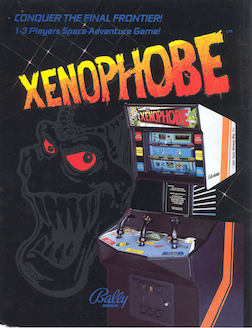
Xenophobe is a video game developed by Bally Midway and released in arcades in 1987. Starbases, moons, ships, and space cities are infested with aliens, and the players have to kill the aliens before each is completely overrun. The screen is split into three horizontally-scrolling windows, one for each of up to three players, yet all players are in the same game world.
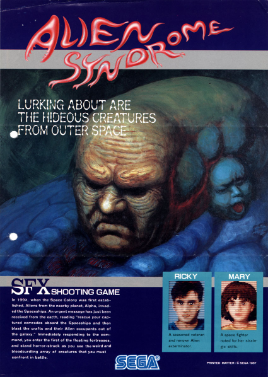
Alien Syndrome is a run and gun video game developed by Sega and released in arcades in 1987, and later ported to the Master System the same year. The game utilizes a side-scrolling feature that allows the player to take control of either a male (Ricky) or female (Mary) soldier whilst hunting aliens and saving hostages before they run out of time.

Defender is a horizontally scrolling shooter developed by Williams Electronics in 1980 and released as an arcade video game in 1981. The game is set on either an unnamed planet or city where the player must defeat waves of invading aliens while protecting astronauts. Development was led by Eugene Jarvis, a pinball programmer at Williams; Defender was Jarvis's first video game project and drew inspiration from Space Invaders and Asteroids. Defender was demonstrated in late 1980 and was released in March 1981. It was distributed in Japan by Taito.

Llamatron is a multidirectional shooter video game programmed by Jeff Minter of Llamasoft and released in 1991 for the Atari ST and Amiga and in 1992 for MS-DOS. Based on Robotron: 2084, players of Llamatron control the eponymous creature in an attempt to stop an alien invasion of Earth and rescue animals—referred to as "Beasties"—for points. Players advance by destroying all of the enemies on each level using a laser that fires automatically in the direction that the Llamatron is moving. Various power-ups exist to aid the player in defeating the wide variety of enemies and obstacles they face along the way.

Xevious is a vertically scrolling shooter arcade video game developed and published by Namco in 1982. It was released in Japan by Namco and in North America by Atari, Inc. Controlling the Solvalou starship, the player attacks Xevious forces before they destroy all of mankind. The Solvalou has two weapons at its disposal: a zapper to destroy flying craft, and a blaster to bomb ground installations and enemies. It runs on the Namco Galaga arcade system.
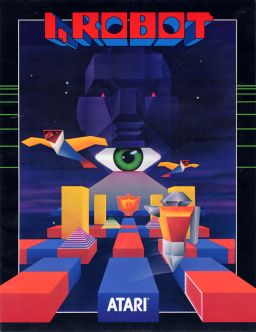
I, Robot is an arcade shooter game developed and released in 1984 by Atari, Inc. Designed by Dave Theurer, only a total of 750–1000 arcade cabinets were produced. The arcade machine comes with two games. The first is I, Robot, a multi-directional shooter that has the player assume the role of "Unhappy Interface Robot #1984", a servant bot that rebels against Big Brother. The object of the game involves the servant bot going through 126 levels, turning red squares to blue to destroy Big Brother's shield and eye. The player can switch to the second game, Doodle City, a drawing tool that lasts for three minutes.

Star Wars is a first-person rail shooter designed by Mike Hally and released as an arcade video game in 1983 by Atari, Inc. It uses 3D color vector graphics to simulate the assault on the Death Star from the 1977 film Star Wars. There are three connected gameplay sequences: combat against TIE fighters in space, flying across the surface of the Death Star, and the final trench run. The sequence repeats with added complications and the Death Star regenerating for each. The player's X-Wing fighter has a shield which only protects against damage a certain number of times, then the next hit ends the game. Speech synthesis emulates actors from the film.

Xenon 2: Megablast is a 1989 shoot 'em up video game developed by The Bitmap Brothers and published by Image Works for the Amiga and Atari ST. It was later converted to the Master System, PC-98, X68000, Mega Drive, Commodore CDTV, Game Boy, Acorn Archimedes and Atari Jaguar platforms. The game is a sequel to Xenon and takes place a millennium after the previous title. The goal of the game is to destroy a series of bombs planted throughout history by the Xenites, the vengeful antagonists of the first game.

Galaga '88 is a 1987 fixed shooter arcade video game developed and published in Japan by Namco and in North America and Europe by Atari Games. It is the third sequel to Galaxian. It features significantly improved graphics over the previous games in the series, including detailed backgrounds, larger enemies and greater ship details. The game runs on Namco System 1 hardware.
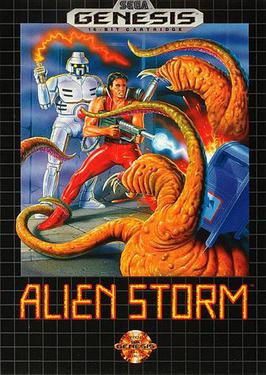
Alien Storm (エイリアンストーム) is a beat 'em up shooter released as an arcade video game by Sega in 1990. It was ported to the Genesis/Mega Drive and Master System. The Mega Drive version was re-released on Wii's Virtual Console in 2007 and was also included on Sonic's Ultimate Genesis Collection for Xbox 360 and PlayStation 3. The game was also re-released on the Nintendo Switch Online + Expansion Pack in 2022.

Dragon Spirit is a 1987 vertical-scrolling shooter arcade game developed and published by Namco. In North America, it was distributed by Atari Games. Controlling the dragon Amur, the player must complete each of the game's nine areas to rescue the princess Alicia from the demon Zawell. Similar to Namco's own Xevious, Amur has a projectile weapon for destroying air-based enemies and a bomb for destroying ground enemies. It ran on the Namco System 1 arcade board.

Zarlor Mercenary is a vertically scrolling shooter for the Atari Lynx handheld console, developed by Epyx and published by Atari Corporation.

Dropzone is a horizontally scrolling shooter developed by Archer Maclean for Atari 8-bit computers and published in 1984 by U.S. Gold. It was ported to the Commodore 64, and later released for the Nintendo Entertainment System, Game Boy, Game Gear, and Game Boy Color. Ports for Master System and Sega Genesis were also announced, but never released.
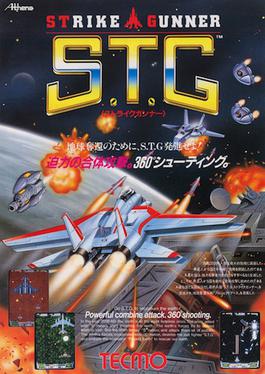
Strike Gunner S.T.G (エス・ティー・ジー) is a vertically scrolling shooter video game released for arcades in 1991 by Tecmo. It was ported for the Super Nintendo Entertainment System. The Super NES version was released in Europe under the title Super Strike Gunner and was published by Activision.

Star Raiders is a video game for the Xbox 360, PlayStation 3, and Microsoft Windows. Developed by Incinerator Studios, it was published in May 2011 by Atari Interactive. It is a re-imagining of 1980's Star Raiders which was the killer app for the Atari 8-bit computers. The remake is an action, first-person spaceship combat game in which the player travels through a starfield in pursuit of the enemy Zylons. It adds a new storyline, customizable ships, and multiplayer gameplay with several modes.
Limbic Software, Inc. is an independent mobile game development company founded in 2009 by Arash Keshmirian, Iman Mostafavi, and Volker Schönefeld. Limbic has designed and developed iOS and Android titles TowerMadness, Grinchmas!, Nuts!, Zombie Gunship, TowerMadness 2, and Zombie Gunship Arcade, with over 25 million game downloads worldwide.
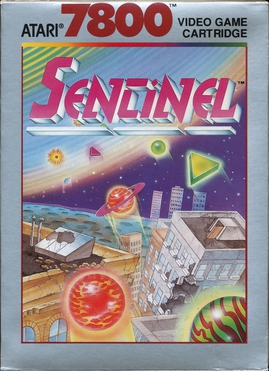
Sentinel is a 1990 video game developed by Imagineering and published by Atari for the Atari 2600. It is the only light gun game ever released for the Atari 2600 platform. It was re-released with improved graphics for the Atari 7800 in 1991.

Stealth is a pseudo-3D rail shooter designed by Tracy Lagrone and Richard Sansom. The game was published in 1984 by Broderbund for the Atari 8-bit computers and Commodore 64.

Xenocide is a scrolling shooter for the Apple IIGS written by Pangea Software and published by Micro Revelations in 1989. An IBM PC compatible port using VGA graphics was developed by Manley & Associates and published in 1990. The box cover credits Brian Greenstone as the game's creator on both versions. Xenocide was the first commercially published game from Greenstone's company, Panega Software.




















